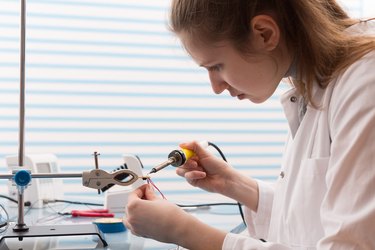
Soldering is typically done with solder wire but you can also use liquid solders which are molten metals developed to join two metal surfaces. They are powerful, water-resistant adhesives that offer an effective alternative approach to the conventional, high-melting point solder interconnects. Liquid solders are an increasingly popular, heavy-duty adhesive choice for many metal workers and contractors.
Types of Liquid Solder
Video of the Day
Liquid solders come either in a tube dispenser or in a can to suit projects of different sizes. Tubes are best suited for smaller jobs and can be applied directly to the intended surfaces. Canned liquid solders are for larger surface adherence, and application will require a wooden paddle or stick. There is a range of liquid solders available on the market, including Permatex, Rosin Flux, PGA PCB and SMD Fluxes.
Video of the Day
Permatex Liquid Solder
Permatex is a specially blended adhesive, which provides a weather-resistant, metal-tough bond once it dries. It is soft, quick-drying and does not require heat. This makes it easy to use and a popular choice, especially among first-time users. It can be used to fill small holes or cracks, as well as to repair split seams in metal. Permatex is also recommended for broken weld lines, floor panels, battery trays and trunk compartments. It should not be used for electrical repairs because it does not contain conductive material.
Rosin Flux Liquid Solder
This is a non-corrosive, liquid solder flux widely used for soldering ground wires to metal chassis, forming hermetic seals, as well as pot tinning of brass and copper parts. A key advantage of this liquid rosin solder flux is that it eliminates the hazards and waste associated with organic, solvent-based liquid fluxes, as well as the removal of corrosive residues by washing. It offers a non-corrosive alternative to chloride and acid types of liquid solders. You can also purchase rosin soldering flux paste.
BGA, PCB and SMD Fluxes
These types of liquid solders are formulated particularly for use with Ball Grid Array, or BGA, equipment and tools. A BGA package is used in electronics for integrated circuits and printed circuit boards (PCB). These liquid solders are also used to connect surface mount devices (SMD) such as resistors and tantalum capacitors for surface mount technology (SMT). The SMD components have connectors to form electrical circuits.
They are high-quality, noncorrosive liquid solders that have a low-temperature melting point, and offer the benefit of preventing CSP Hydroplaning. These liquid solders are nonconductive when dry, making them well-suited for Re-Balling. They make cleaning much easier because of their low residue formulation. Kester also makes a no-clean, rework flux to repair and rework these components.
Liquid Solder Flux Application Instructions
For optimum results, the surfaces to be adhered together should be clean, smooth and dry. The soldering process only requires you to apply the liquid solder on one of the surfaces. Once applied, the bonded objects should be clamped together for 20 to 30 minutes to form a firm bond. Ideally, they should be left undisturbed for up to 24 hours to form a bond of maximum strength. The bond can be released by applying acetone, which dissolves the bond formed by the liquid solder.